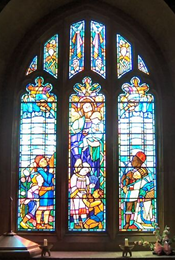St Mary's
Early History of St Mary's
The first record of a church of the site of St Mary’s was in the Doomsday Book (1086), and the shaft of a Saxon Cross, now displayed in the church, was found on the site. It also has a font dating from Norman times.
The original church was probably of wood and thatch and replaced with a stone building in 1326. The church was subsequently much altered, rebuilt and repaired. Its dilapidated tower was rebuilt in 1829. It has since been an important local landmark and survived the Blitz of 3rd-4th May 1941 when incendiaries almost totally destroyed the church. Rebuilding started in 1947 and the present building was opened in 1953. Most recently, the doors were replaced after an arson attack in May 2020.

The name ‘Walton’ derives from the Anglo-Saxon ‘Waletone’ meaning Tun, or settlement, of the Britons - indicating an origin in the 6th or 7th century. This date is supported by the circular shape of the old churchyard and the shaft of a Saxon Cross which was unearthed in the churchyard. The settlement and church of Walton are first recorded in the Domesday Book (1086). In 1093 the church and tithes were granted to the Abbey of St Peter & St Paul at Shrewsbury.
The style of the carving on the font is Anglo-Saxon, but the font may date from Norman times. It was removed from the church 1754 to be replaced by a new font costing £2 15s 4d. It stood outside a local pub for many years – used as a water trough for animals – before being restored to the church in 1887. During the destruction of the church in 1941 the bells unfortunately crashed down onto it. It was carefully restored by E Carter Preston, a well-known sculptor and designer, who also designed the present stained-glass windows. The bells were re-cast and two more added.
The Mother Church of Liverpool
In Norman times, the Parish of Walton included not only Walton and Liverpool but extended to West Derby and as far north as Formby and Ainsdale. Prior to 1200, it also included Sefton (with Aintree, Crosby and Thornton) and before the Norman Conquest, had also included Childwall.
During the Middle Ages this straggling 40 square mile parish was served by Chapels of Ease to save people having to travel so far to worship. In 1361, during the Black Death, the chapel of St Nicholas in Liverpool was granted the right to bury their dead in their own churchyard; but it was only in 1699 that Liverpool became a separate parish.
As the population grew in the Industrial Age, particularly during the Victorian period, many other independent churches were subsequently established.
In 1990 the churches of St Nathanael (Fazakerley Road) and St Aiden (Cherry Lane) were re-combined into a single parish with St Mary’s to form the Walton Team Ministry.
Present Church Building
We have no information about the original church building which was demolished and rebuilt in 1326. Multiple repairs and alterations were carried out over the subsequent centuries. In 1651 the church was used to house prisoners for several months, after the final defeat of the Royalists at the Battle of Worcester. The costs for the resulting damage – in excess of £20 – had to borne by the parish. The present tower, 118 feet in height, was built in 1829 and the Hornby Chapel added in 1911.
From 1st – 7th May 1941 Liverpool was subjected to sustained night-time bombing raids by the Luftwaffe. On the night of 3rd/4th St Mary’s Church was hit by incendiary bombs – resulting in just one of over 400 fires burning in the city that night. By morning, most of the church had been destroyed. Only the tower and vestry survived intact. Reconstruction started in 1947 to a design by Colonel Gee. The church was reconsecrated in 1953.
A theft of copper from the roof in 2018 caused considerable damage. The 19th century front doors, which had been removed for safekeeping at the outbreak of the war, were destroyed by an arson attack during the Covid lockdown in spring 2020 and had to be replaced.